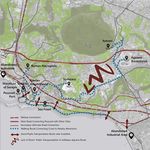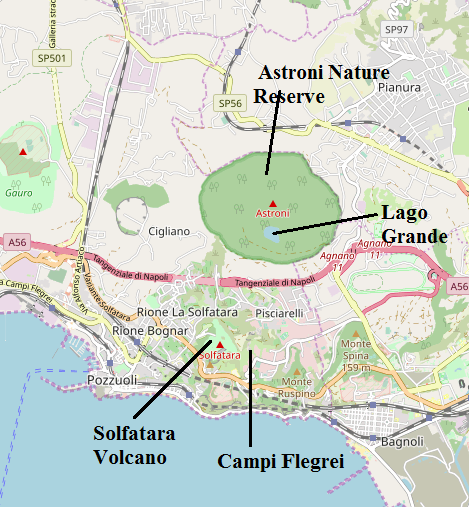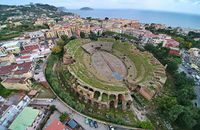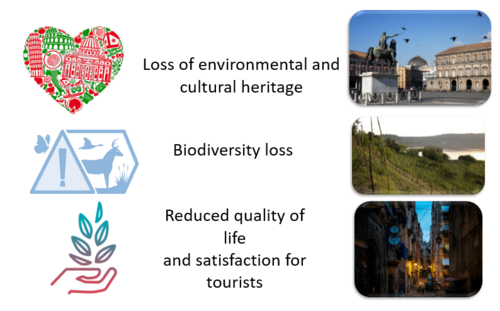Case Study A.1: Pozzuoli-Solfatara-Astroni
>>>back to working groups overview
Rationale
Keywords: mixt area, biodiversity, economic potential
Pozzuoli-Solfatara-Astroni area is very important as a mixt area, consisting in an urbanized area and a biodiversity and various landscape forms that highlight the potential of the area.
The further study case is structured in three steps: understanding coastal lanscape, evaluation and assessment for coastal landscape (a diagnostic of the area, what are the ”symptoms” and most important, the causes of them) and, finally, an integrated planning and design for coastal landscapes (ideas and projects to solve or improve the present situation discovered in the first two steps to protect and highlight the main characteristics of the zone).
Furthermore, the case study will have two big perspectives: the need of urbanization, touristic development and to cover the need for the locals and tourists (outlining the need for a stable and efficient economic system) and the need to protect the biodiversity and the landscape. This two need should merge, support each other and define a complex systems in which every element and relationship between them are to be considered in the future development of the area.
Location and scope
You can edit this map with the map editor
Phase A: Landscape System Analysis
A.1 Landscape layers and their system context
Geomorphology, landscape units and coastal typology
Typology: Volcanic geomorphology- Volcanic Coast
Volcanism creates and degrades lanforms (directly), and provides and age for both the landsurface over which the erupted material lies and the succession in which is intercalated (indirectly). Volcanic geomorphogy, in contrast to other types of landforms, result from both constructive and destructive forces near-simultaneously.
The Solfatara area and its fumaroles are the main surface expression of the vigorous hydrothermal activity within the active Campi Flegrei caldera system. A range of volcanic and structural processes dictate the actual state of the hydrothermal system below the crater. The presence of a large variety of volcanic products at shallow depth (including ash beds, pyroclastic density current deposits, breccias, and lavas), and the existence of a maar-related fault system appears to exert major controls on the degassing and alteration behavior. Adding further to the complexity of this environment, variations in permeability and porosity, due to subsoil lithology and alteration effects, may further influence fluid flow towards the surface.
The hydrothermal activity across the crater floor of Solfatara produced very different morphologies and types of soils. In this area we can find the following sobsoil type: 1. Zones dominated by thin, laminated depoits of finegrained material are found around the two bubbling Fagaia mud pools. 2. A firm fine-grained level, mostrly composed of amorphous silica, has formed in the western altered part of the crater where this depost covers that of the Fangaia mud pools. 3. A subsoil made up of subordinate fine-grained and mainly sandy/pebbly levels characterizes the center of the crater. 4. Large mounds made of sulfur-cemented sandy/pebbly levels and minor intercalated fine-grained levels, covered by a hard, surficial patina.
Coastal elevation changes can occur in area affected by volcanic-tectonic deformation. This phenomenon is found in the Pozzouli zone- the archaeological ruins of Pozzuoli on the Phlegrean Fields in the Bay of Naples- the bioeroded columns of the port’s Roman market were made famous. Relative sea-level movements at Pozzuoli are far more intense than the average 50 cm sea level rise recorded in the north west Mediterranean Sea since Roman times. There are 3 key moments post Roman period: first, submersion in a period of marine transgression (AD 400-550), without volcanic eruption, second, submersion affected the land without eruptive activity followed this inundation (AD 700-900), and third, submersion occurred in the Middle Ages when it was a major eruption in 1538. More recently, the sea level grew with 3.5 m, although no eruption occurred during those periods. The dominant sea-level change signal is linked to phases of volcanic activity and quiescence.
The most important sites in the case study of Pozzouli-Solfatara-Astroni area that should be detailed are: Campi Flegrei and the Astroni Nature Reserve.
Campi Flegrei is a 75 km2 volcanic area located to the west of Naples. It was declared as a regional park in 1997. This area both geology and history. Campi Flegrei comprises a substantial number of sites that are remarkable for scientific quality, rarity, aesthetic appeal and educational value, valuable for their geological heritage. The interest for both scientists and general public (locals and tourists) is archaeological, ecological, historical or cultural. The Campi Flegrei volcanic sites also represent one of the highest volcanic risk areas in the world. Important geosites that are included in Campi Flegrei is Cuma, Averno, Monte Nuovo, Solfatara, Piperno and Monte di Procida.
Astroni Nature Reserve has been well known since the of Ancient Rome, when it was used for therapeutic baths. After the unification of Italy, Astroni suffered progressive degradation. Touristic attraction uncontrolled and unregulated use of the land destroyed the natural environment. Nowadays, Astroni Reserve belongs to the Campania Region. It comprises one of the volcanic craters of Campi Flegrei and is situated 16 km from the center of Naples. The Astroni crater is home to a great variety of habitats.
The coastal typology is in a slow change due to diverse factors, such as: earthquakes, landslides, volcanic eruption, uncontrolled hazard zones (see Hazard maps below), and uncontrolled human intervention in the area and in the surrounding area.
Land use
Pozzouli was founded about 531 BC by Greek emigrants who called it Dicaearchia, the city of justice. After captured by Rome, it had the status of a Roman colony from 194 BC. The Romans called the city Puteoli which means small wells, perhaps due to the availability of numerous thermal-mineral water springs. After Roman conquering the East, the need to have a stopover open to traffic with it made Puteoli the Mediterranean port of Rome which made it a leading commercial centre and a cosmopolitan city. However, it declined with the fall of the Roman Empire and the gradual sinking of the Puteolan coast, caused by bradyseism, a slow vertical movement of soil, forced the inhabitants to leave the lower part and the harbor areas of the city and to settle on the hill at the end of the 5th century or at the beginning of the 6th century. Many traces of the Roman city survive, including well-preserved amphitheatre, baths and underground chambers while changes in the level of the land even caused temple porticoes along the shore to be submerged beneath the sea. In the early 1970s the old Roman market, the Temple of Serapis of the 1st century AD was partially submerged due to bradyseismic activity. After the phenomena occurred in the seafront, urban expansion moved toward internal and more rural areas which was completely sudden and unregulated.
Pozzuoli is on the Rome-Naples railway line and has a small commercial port. Public Transportation is good near coastline while time consuming with indirect public transportation services towards north. The economy of this area is based largely on tourism, commerce, industry and agriculture. The local volcanic material is used for making the fine cement called pozzolana named after the town. The fertile countryside supports a major food-processing industry in the town, which also engages in fishing and the manufacture of machinery. Between the two World Wars Pozzuoli was an important industrial pole for battleships weaponry. A number of residents work in the iron- and steelworks at nearby Bagnoli. Many factories have shut down within the last few decades.
Thus, Pozzuoli the connecting point of rural, urban and industrial areas has gone through massive urbanization specially in the coastal area through last fifty years. In this area urban fabric is denser in the hillside coastal area with mostly three to five storied buildings. The pedestrian friendly green belt alongside the coastline provides a welcoming seafront for the citizens. The area has still vast fragmented green areas of broad leaved forest, agriculture land, herbaceous plant vegetation, pastures as well as small urban green patches which are positive aspects of this site. There is also dominance of industrial and commercial area close to the coast while some future planning can be thought about the abandoned industrial areas. A huge aeronautical academy is currently working in top of the hill providing professional trainings to young people. There are some other land uses like sports, recreation & also mineral extraction from solfatara, a semiactive volcano which is a famous touristic spot as well. Overall the current urban fabric and the commercial area are dominating the site & will possibly be dominating in future as well with a threat of converting landuses due to massive tourism and population growth. However, considering ecological connection through the green areas and improving public transportation services specially between Agnano and Solfatara could be a great opportunity to achieve sustainable development goals.
Green/blue infrastructure
As the European commission defines it, the Green Infrastructure represents a network of healthy ecosystems that often provides cost-effective alternatives to traditional 'grey' infrastructure and offers many other benefits for both EU citizens and biodiversity. Some of the main benefits provided by GI would be improved habitats for wildlife, ecological corridors and ladscape permeability. Society as a whole would be affected, not just the biodiversity if the natural powerhouses are damaged. In the study Green infrastructure is well represented in Astroni Natural Craters Reserve, which is included in the Natura 2000 network since 1995, under Birds Directive and Habitats Directive protecting 31 species and 2 habitats. The flora and fauna are very various, known as one of the richest places of Naples for birds diversity. Also inside the reservation the blue infrastructure is represented by three small lakes: Lago Grande, Cofaniello Grande and Confaniello Piccolo. Additionally it is important to mention the famous Solfatara in the northeast, a semiactive volcano that exhales sulfurous vapours and gives vent to liquid mud and hot mineral springs. Altough the study presents an important economic and touristic development, it’s essential to maintain the balance between nature and citizens. The underlying principle is that the same area of land can offer multiple benefits, if its ecosystems are in a healthy state, GI serving the interests of both people and nature.
Actors and stakeholders
- The first type of stakeholders is organizations and governmental associations in the area. The area is under the supervision of the municipality of Pozzuoli which is one of the main stakeholders with the high level of interest and the influences. The municipality of Pozzuoli is responsible for urbanistic plans and programs. The Superintendence for cultural heritage is the highest-ranked interest organization in the area that is caring for landscape and developing leisure and recreation of the area. Campania Region, as one of the stakeholders with a considerable level of interest, is planning for seashore protection and masterplan. Local people, tourists, investors, and businessman are considering as the second type of stakeholders. This type has a crucial role in the eco-social and environmental situation of the area. They can lead by the first group of the stakeholders to improve and promote the development factors of the area of the Pozzuoli.
Sacred spaces and heritage
The Flavian Amphitheater is the third largest Roman amphitheater in Italy. It was begun under the reign of the emperor Vespasian and probably finished under the reign of his son Titus. The arena can hold up to 50,000 spectators. The interior is mostly intact and one can still see parts of gears which were used to lift cages up to the arena floor. The site of the structure was chosen at the nearby crossing of roads from Naples, Capua and Cumae. It was abandoned when it was partially buried by eruptions from the Solfatara volcano. During the Middle Ages, the marble used on the exterior was stripped, but the interior was left alone and is perfectly preserved.
The Temple of Serapis sits not far from the sea in the ancient town of Pozzuoli.It is not a temple at all, as its name would suggest, it is an important symbol of the region’s Roman roots, and more importantly, of the geologic forces at play in the Campi Flegrei. Serapis is the god of the underworld, as well as the god of the sun, healing, and fertility. Ptolemy I of Egypt created Serapis as an Egyptian-Greek god to unite the two cultures. Near the macellum there is that it lies about 30 feet below sea level. Its ancient granite columns seem to be suspended atop a mirky pool of water, leaving you with the impression that they are either rising up from or descending into the sea. Originally attributed to changes in sea level, geologists later learned that the ground was moving slowly up and down with the ebb and flow of magma chambers deep within the earth. From the Greek bradus, slow and sism movement, bradyseism is prevalent throughout the Campi Flegrei and the macellum is perhaps the most important example of it in the world. In fact, scientists have been documenting the ruins’ movements since the 18th century, when they found evidence of molluscs on several columns indicating that the columns were at one time submerged to a depth of at least 7 meters.
- Your case sacredspace2.jpg
add a caption
- Your case sacredspace3.jpg
add a caption
Visual appearance and landscape narrative
The Solfatara of Pozzuoli is a volcanic crater characterized by its sulphurous soil. As the shallow crater is also filled with underground water, jets of steam pierce the crust of earth while the ground seems to tremble and almost boil, and hot mud comes to the surface bubbling over. The area is permeated by the strong smell of sulphur, it looks like the gates of Hades.
The first engraving above is an extraordinary proof of the expeditions of Sir William Hamilton by Peter Fabris. Hamilton is ambassador of the British Empire in Naples, a keen observer of local life and customs, as far as the scientific aspect is concerned. He has the task of informing British scholars about the activities of Vesuvius and Phlegraean Fields and the archaeological of Pompeii and Herculaneum. He visits the Solfatara of Pozzuoli even during eruptions to observe better the evolution. In this pictorial testimonies, Hamilton observes the gas fumes from a mouth of the Solfatara of Pozzuoli. The second engraving is from an original by Mercati. The beauty of the composition relies on the circular shape of the crater which, in reality, has a more irregular and elongated shape. The third picture instead, is Stradanus’ engraving who puts less emphasis on the composition and on the crater itself, but in his description is rich in dramatic in detail. Stradanus is particularly successful at depicting the light,the dirt at the centre of the crater and its quality, which is sandy at the top, and moving, almost fluid just below. He also situates the solfatara in its urban context
- Your case character1.jpg
add a caption
- Your case character2.jpg
add a caption
- Your case character3.jpg
add a caption
A.2 Summary of you landscape system analysis and your development Targets
The Sustainable Development Goals are the blueprint to achieve a better and more sustainable future for all. Some of the goals targeted for 2030 for sustainable development are at risk in the area of Pozzouli-Solfatara-Astroni.
Build resilient infrastructure, promote sustainable industrialization and foster innovation, Goal 9: We can upgrade infrastructure and retrofit industries to make them sustainable, with increased resource-use efficiency and greater adoption of clean and environmentally sound technologies. Also adaptive reuse of abandoned industries can ensure certain benefit.
Make cities inclusive, safe, resilient and sustainable, Goal 11: It is possible to strengthen our efforts to protect and safeguard cultural and natural heritage and providing universal access to safe, inclusive and accessible, green and public spaces.
Take urgent action to combat climate change and its impacts, Goal 13: Strengthening resilience and adaptive capacity to climate-related hazards and natural disasters is also required.
Conserve and sustainably use the oceans, seas and marine resources, Goal 14: We need to prevent and significantly reduce marine pollution from land-based activities, including marine debris and nutrient pollution. Also sustainably managing and protect marine and coastal ecosystems to avoid significant adverse impacts, including by strengthening their resilience, and take action for their restoration in order to achieve healthy and productive oceans.
Sustainably manage forests, combat desertification, halt and reverse land degradation, halt biodiversity loss, Goal 15: Ensuring the conservation, restoration and sustainable use of freshwater ecosystems and their services, in particular forests, wetlands and hilly areas in line with obligations under international agreements. Promoting the implementation of sustainable management of all types of forests, halt deforestation, restore degraded forests and substantially increase afforestation and reforestation is also necessary.
DPSIR Framework is used for system analysis of the area. Population growth is recognized as a major driving force, which together with economic development puts pressures on the human and natural environment. As a consequence, there is landscape fragmentation, loss of natural and cultural heritage as well as deteriorated human wellbeing. A holistic approach to integrated development is a necessary response, which includes various steps for recognizing and conserving the values of the area.
At the current state the urban sprawl, fragmentation of landscapes and ecosystems and as well as the reduced quality of environment are leading the area to three main consequences: Loss of environmental and cultural heritage, biodiversity loss and also reduced quality of life for locals and a decreasing number of tourists. As a result of the rapidly urbanizing areas, agriculture intensifies on remaining undeveloped land and is likely to expand to new areas, putting pressure on land resources. The loss of biodiversity can be related to the antrophic activities. Humans have destroyed and continue to destroy the habitats of species on a daily basis.
A.3 Theory reflection
- Reflect on at least three international policy documents in relation to their local landscape case
- choose one international, one European and one national document
- You can choose references from our reading list
- Scope: 250 words
- UN HABITAT. New Urban Agenda: As the area characterized by rapid urbanization as the consequence of population growth, Puzzuoli coast is facing challenges such as Social (Migration), Climate change, Economic development, Demographic change, and Environment recourse management. The New Urban Agenda as guidance for further integrated urban development can facilitate mitigation of the problems such as urban sprawl, losing the identity of the space, unsustainable resource use and lack of participation, mainly through the dialog between multi-stakeholders (public and private sector, working with civil society).
A.4 References
- https://en.wikipedia.org/wiki/Economy_of_Naples, date 04.04.2019
- https://www.britannica.com/place/Pozzuoli, date 04.04.2019
- http://www.naplesldm.com/geology.php, date 04.04.2019
- https://www.google.com/maps, date 04.04.2019
- https://land.copernicus.eu/local/urban-atlas/urban-atlas-2012, date 04.04.2019
- https://land.copernicus.eu/pan-european/corine-land-cover, date 04.04.2019
- https://www.un.org/sustainabledevelopment/sustainable-development-goals/, date 04.04.2019
- https://www.academia.edu/12322699/Community_Supported_Agriculture_in_the_Urban_Fringe_Empirical_Evidence_for_Project_Feasibility_in_the_Metropolitan_Area_of_Naples_Italy_
- https://en.wikipedia.org/wiki/Pozzuoli, date 04.04.2019;
- https://en.wikipedia.org/wiki/Solfatara_(volcano), date 04.04.2019;
- http://eunis.eea.europa.eu/sites/IT8030007, date 04.04.2019;
- https://www.wwf.it/oasi/campania/cratere_degli_astroni/, date 04.04.2019;
- http://ec.europa.eu/environment/nature/ecosystems/index_en.htm, date 04.04.2019;
- Paolo Camilletti, Gianluca Lanzi, Natural and man-made landscape in the Phlegraean Fields: Linking identity and potentials for sustainable development. TRIA 20 (1/2018) 119-140/ e-ISSN 2281-4574. Accessed: 03.04.2019
- https://www.napoliunplugged.com/cratere-degli-astroni-nature-reserve.html, date 04.04.2019;
- http://ec.europa.eu/environment/nature/legislation/habitatsdirective/docs/Int_Manual_EU28.pdf, date 04.04.2019;
- https://www.eea.europa.eu/themes/landuse/land-cover-country-fact-sheets/it-italy-landcover-2012.pdf/view, date 04.04.2019;
- https://www.researchgate.net/publication/268096157_Coastal_Geomorphology_and_Sea-Level_Change, date 04.04.2019;
- https://urban.yale.edu/research/theme-4, date 04.04.2019;
- https://link.springer.com/article/10.1007/s12371-011-0033-1, date 04.04.2019;
- https://www.frontiersin.org/articles/10.3389/feart.2017.00072/full, date 04.04.2019;
- https://link.springer.com/article/10.1007/s12371-011-0033-1 , date 04.04.2019;
- https://www.researchgate.net/publication/320989930_Hydrothermal_activity_and_subsoil_complexity_implication_for_degassing_processes_at_Solfatara_crater_Campi_Flegrei_caldera, date 04.04.2019;
- https://www.vulcanosolfatara.it/en/, date 04.04.2019;
- https://www.wwf.it/oasi/campania/cratere_degli_astroni/cratere_degli_astroni__english_version_.cfm, date 04.04.2019;
Phase B: Landscape Evaluation and Assessment
B.1 Assessment Strategy
- Based on the hypothesis derived from your previous landscape systems analysis you are now asked to define the goals for assessing the landscape. Your assessment is the basis for evaluating the landscape status.
- Which elements and phenomena need to be mapped, why and how?
- This a text contribution, max 250 words
B.2 Mapping
- As defined by your assessment strategy you conduct the mapping and present your findings here
- As a minimum, at least three different themes need to be mapped, you may choose more if needed
- Your case your assessment mapping themel.jpg
briefly explain the findings of your mapping
- Your case your assessment mapping theme2.jpg
briefly explain the findings of your mapping
- Your case your assessment mapping theme3.jpg
briefly explain the findings of your mapping
B.3 Problem definition and priority setting
- Give a summary of the major findings of your mapping process, what are the problems/potentials identified?
- Draw a problems/potentials map
- Set priorities for the most relevant issues
- Your case problems potentials map.jpg
add caption here
B.4 Theory reflection
- Please reflect the assessment and evaluation methods used based on at least three readings
- Did you encounter limitations'
- 200 words test contribution
B.5 References
- give a full list of the references you have used for this section
Phase C – Strategy and Master Plan
C.1 Goal Setting
- Define strategic planning objectives based on the evaluation findings
- Link back to your original targets from section one and the Development Goals
- 150 words text contribution
C.2 Spatial Strategy and Transect
- translate your strategic goals into a vision
- develop a spatial translation of your vision
- exemplify your vision in the form of a transect with concrete interventions
- add map(s) and visualizations
- Your case spatial translaton vision.jpg
add caption here
- Your case transect.jpg
add caption here
- Your case transect detail1.jpg
add caption here
- Your case transect detail2.jpg
add caption here
C.3 From Theory of Change to Implementation
- For implementing your vision: Which partnerships are needed? Which governance model is required?
- Who needs to act and how? Draw and explain a change/process model/timeline
- Which resources are needed? On which assets can you build?
- add 150 words text and visuals
- Your case spatial your governance model.jpg
add caption here
- Your case spatial your process model.jpg
add caption here
C.4 References
- give a full list of the references you have used for this section
D. Process Reflection
- Reflect in your intercultural and interdisciplinary team on the outcomes of your study
- Which limitations were you facing?
- What have you learnt from each other?
- What would you do differently next time?
- You can also use diagrams/visuals
- 250 words text




















